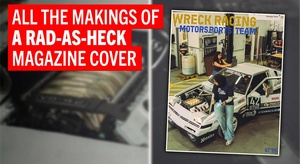
Having been raised on a steady diet of “if it seems too good to be true, it probably is” a product claiming that we could install it in minutes and it would allow us to add magic juice to our car and instantly make more horsepower seemed to carry a bold claim.
A couple dyno runs later, and we’re ready …
Read the rest of the story

te72
Reader
6/27/19 10:35 p.m.
Filling a gas can in the bed of a pickup? I'm all for 'splosions myself, but I prefer not to be the source of them...
te72 said:
Filling a gas can in the bed of a pickup? I'm all for 'splosions myself, but I prefer not to be the source of them...
I thought you were just supposed to keep the nozzle in contact with the surface of the can? The pump is grounded, so that completes the circuit, right?
Even if the pump is grounded, it's not the same "ground" as the truck, since the truck is insulated from the ground-ground with rubber tires. So it's not a complete circuit.
That's just my guess though. I'm no electrical engineer.
tyronejk said:
Even if the pump is grounded, it's not the same "ground" as the truck, since the truck is insulated from the ground-ground with rubber tires. So it's not a complete circuit.
That's just my guess though. I'm no electrical engineer.
You know that makes perfect sense. Glad I've avoided immolation to this point. Habit changed.
JG Pasterjak said:
On the dyno, the results were unambiguous, though. We saw gains of 15hp and 18ft./lbs. of torque, simply by switching fuel with the unit in place. That’s with no additional tuning, just plugging and playing. More power is likely available to be unlocked with a dedicated E85 tune.
This is expected. You are suppling a more oxygen per mole of E85 vs. gasoline.
Science:
E85 chemical makeup: C2H6O
Gasoline chemical makeup: C8H18
I.E. You are adding oxygen via a slight form of shall we call it "chemical supercharging". While pure gasoline only composes of carbon and hydrogen, ethanol includes an oxygen atom in it's chemical composition. This is generally why, when all other factors of a tune are kept the same (even timing) and the only thing that is adjusted is the fueling, E85 will gain HP/TQ because of science. Anyone who says otherwise needs to hit the books again.
OK, so what is the correct way? Fill the cans when they are sitting on the ground? Please let us know.
I always assumed it didn't matter where you filled a plastic fuel jug because the jug itself is non-conductive. But I have been wrong before...
I fill my plastic fuel jugs often and always put them on the ground because I don't want to spill anything in my vehicles.
Thanks!
Filling jugs in the bed of the truck can result in a spark and fire. Always place them on the ground.
GRM:
Where the members don't talk about how cool it is to get a power bump from changing fuel, instead, argue about the proper way to fill a fuel jug.
Gents, in reality, it's not a big risk, or even a small one. I worked at QT for years in high school and college, watched hundreds of people smoke cigarettes AS THEY WERE FILLING UP THEIR TANK...............you know how many pump fires I saw in 4 years of workin at a gas station with 20 pumps.
If you said, ZERO, you'd be exactly correct.
In reply to z31maniac :
But obviously it has happened, or there wouldn't be warning signs AT EVERY SINGLE PUMP.
E85 Story: Does this cause issues with fuel system components? Don't you need stainless lines and special hoses to run E85?
llysgennad said:
E85 Story: Does this cause issues with fuel system components? Don't you need stainless lines and special hoses to run E85?
The answer is: Depends.
On our Z06, no hardware changes were required to be E85 compliant. On other cars, there may be more substantial hardware or hose requirements. That's definitely something we'll be talking about on the July 3rd show, because I'm curious, too.
JG Pasterjak said:
llysgennad said:
E85 Story: Does this cause issues with fuel system components? Don't you need stainless lines and special hoses to run E85?
The answer is: Depends.
On our Z06, no hardware changes were required to be E85 compliant. On other cars, there may be more substantial hardware or hose requirements. That's definitely something we'll be talking about on the July 3rd show, because I'm curious, too.
Yep. The fuel lines are fine with E85. There has been ethanol in fuel for what, 30+ years now?
The big issue is does your stock fuel system have the extra capacity for E85, or do you have to upgrade. E85 takes about 30% more fuel than normal 91/93, some cars, like the BRZ/FR-S can support nearly double the stock HP on the stock fuel system. Other cars can barely handle a gentle tune.
z31maniac said:
JG Pasterjak said:
llysgennad said:
E85 Story: Does this cause issues with fuel system components? Don't you need stainless lines and special hoses to run E85?
The answer is: Depends.
On our Z06, no hardware changes were required to be E85 compliant. On other cars, there may be more substantial hardware or hose requirements. That's definitely something we'll be talking about on the July 3rd show, because I'm curious, too.
Yep. The fuel lines are fine with E85. There has been ethanol in fuel for what, 30+ years now?
The big issue is does your stock fuel system have the extra capacity for E85, or do you have to upgrade. E85 takes about 30% more fuel than normal 91/93, some cars, like the BRZ/FR-S can support nearly double the stock HP on the stock fuel system. Other cars can barely handle a gentle tune.
Yes, but in the US it has only been federally mandated that fuel system components need to be capable of holding up to some amounts of ethanol since 2004/2006.
Need one for a Honda Grom or a side-by-side? They gotchu.
Import car? berkeley off!
And as someone who dabbles in being gas-station trained, yeah, not the best move (and possibly illegal, IDK how they roll down there)

goingnowherefast said:
z31maniac said:
JG Pasterjak said:
llysgennad said:
E85 Story: Does this cause issues with fuel system components? Don't you need stainless lines and special hoses to run E85?
The answer is: Depends.
On our Z06, no hardware changes were required to be E85 compliant. On other cars, there may be more substantial hardware or hose requirements. That's definitely something we'll be talking about on the July 3rd show, because I'm curious, too.
Yep. The fuel lines are fine with E85. There has been ethanol in fuel for what, 30+ years now?
The big issue is does your stock fuel system have the extra capacity for E85, or do you have to upgrade. E85 takes about 30% more fuel than normal 91/93, some cars, like the BRZ/FR-S can support nearly double the stock HP on the stock fuel system. Other cars can barely handle a gentle tune.
Yes, but in the US it has only been federally mandated that fuel system components need to be capable of holding up to some amounts of ethanol since 2004/2006.
It's still not automatically able to handle E85. Our newish 2016 car is only rated for E15 or less.
z31maniac said:Gents, in reality, it's not a big risk, or even a small one. I worked at QT for years in high school and college, watched hundreds of people smoke cigarettes AS THEY WERE FILLING UP THEIR TANK...............you know how many pump fires I saw in 4 years of workin at a gas station with 20 pumps.
If you said, ZERO, you'd be exactly correct.
I've seen zero of many things that I am still careful not to cause.
Here's an example of it happening: https://www.youtube.com/watch?v=8wiUBCMdO7Y
It goes from "no fire" to "man and truck engulfed in flames" in seconds. I would really like to avoid that happening to me or anyone I know or anyone at all, really.

edmagoo
New Reader
6/28/19 3:40 p.m.
In reply to goingnowherefast :
Not really. Your goal is to combine the fuel's hydrogen and carbon with oxygen. However some of the chemical bonds in E85 are already combined with oxygen. So you don't get that energy. That's a net energy loss compared to gasoline.
The gains are based on flame speed and knock resistance not power content.

dculberson said:
z31maniac said:Gents, in reality, it's not a big risk, or even a small one. I worked at QT for years in high school and college, watched hundreds of people smoke cigarettes AS THEY WERE FILLING UP THEIR TANK...............you know how many pump fires I saw in 4 years of workin at a gas station with 20 pumps.
If you said, ZERO, you'd be exactly correct.
I've seen zero of many things that I am still careful not to cause.
Here's an example of it happening: https://www.youtube.com/watch?v=8wiUBCMdO7Y
It goes from "no fire" to "man and truck engulfed in flames" in seconds. I would really like to avoid that happening to me or anyone I know or anyone at all, really.
Possible and probable are two words that are often misunderstood.
It's possible that Russia could launch a nuclear strike in the 27 minutes, but it's not probable that it will happen.
As well all complain about people buying trucks and SUVs instead of something fun, it's a similar logic, "I will buy a truck on the off-chance I need it 3 times a year, instead of saving money and renting a truck from Home/Lowe's for $20 for the day to do truck things when I need it."
But using extremes online is more fun.

goingnowherefast said:
z31maniac said:
JG Pasterjak said:
llysgennad said:
E85 Story: Does this cause issues with fuel system components? Don't you need stainless lines and special hoses to run E85?
The answer is: Depends.
On our Z06, no hardware changes were required to be E85 compliant. On other cars, there may be more substantial hardware or hose requirements. That's definitely something we'll be talking about on the July 3rd show, because I'm curious, too.
Yep. The fuel lines are fine with E85. There has been ethanol in fuel for what, 30+ years now?
The big issue is does your stock fuel system have the extra capacity for E85, or do you have to upgrade. E85 takes about 30% more fuel than normal 91/93, some cars, like the BRZ/FR-S can support nearly double the stock HP on the stock fuel system. Other cars can barely handle a gentle tune.
Yes, but in the US it has only been federally mandated that fuel system components need to be capable of holding up to some amounts of ethanol since 2004/2006.
Ethanol cut fuel has been here since the late 70s, I don't remember any of the cars I owned from the 80s, that were already decades old, having fuel line failures.
llysgennad said:
In reply to z31maniac :
But obviously it has happened, or there wouldn't be warning signs AT EVERY SINGLE PUMP.
You mean like all of those horrifying incidents where people talked on their celphones and perished during refueling? Because, yeah.
As for E85, for me it wasn't so much the relatively minor power bump I saw when I switched, it was the cooling. 450->475 whp, but 285->260 degree oil temperatures in midsummer.

te72
Reader
6/28/19 9:14 p.m.
Maybe I'm in the minority, but I tend to read warning signs once or twice. Could just be my nature, or it could be the frequent safety training at work.
Figure I've known enough people who learned the hard way to learn from their mistakes. Fortunately nobody's 'sploded themselves yet, but again, there's a reason for every sign, per How I Met Your Mother. =)
Love that about GRM, how easily sidetracked we can get sometimes. Some of us are special *raises hand* but this whole place is special. =P
Take a lesson from the General Aviation Arena. Standard Operating Procedure when refueling a plane is to connect a ground wire from the pump frame to the frame of the airplane before you do ANYTHING else. Then proceed with the usual bit of uncapping the wing tanks (or where ever they might be on the aircraft in question ), sticking the nozzle in and starting the pumping fuel process. There is a reason they do it that way. Aside from the fact that the FAA has always erred on the side of extreme caution, an aircraft moving through the air at relatively high speeds can build up a serious static charge and having that discharge itself into an open almost empty fuel tank with lots of vaporized fuel makes for really spectacular fireworks. Helicopters generate a ton of static electricity with their rotors so when the coast guard does rescue at sea they lower a grounding lead to discharge the static and avoid killing the people they are rescuing.
livinon2wheels said:
Helicopters generate a ton of static electricity with their rotors so when the coast guard does rescue at sea they lower a grounding lead to discharge the static and avoid killing the people they are rescuing.
I'm really glad I wasn't lied to by "Hunt for Red October"

z31maniac said:
Possible and probable are two words that are often misunderstood.
It's possible that Russia could launch a nuclear strike in the 27 minutes, but it's not probable that it will happen.
As well all complain about people buying trucks and SUVs instead of something fun, it's a similar logic, "I will buy a truck on the off-chance I need it 3 times a year, instead of saving money and renting a truck from Home/Lowe's for $20 for the day to do truck things when I need it."
But using extremes online is more fun.
It's possible - but perhaps not probable - you can be immolated in an enormous and massively painful fire. You can avoid it by setting the gas cans on the pavement while filling them. Your response is "too much work, that's not likely?" OK - but I'm going to continue setting my gas cans on the pavement before filling them. The cost is nonexistent and the danger it's avoiding is pretty massive.
Note sure why you feel this relates to SUVs and nuclear strikes. Kind of a stretch, dude.































